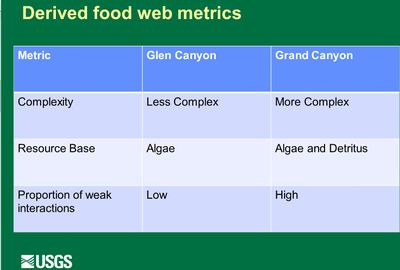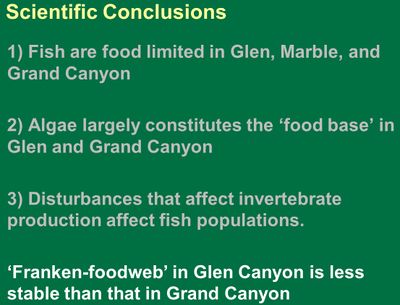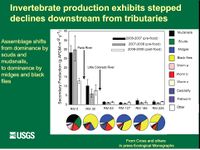Difference between revisions of "FOOD BASE"
(add tcd effects on algae and inbertebrates) |
(add article about foodbase) |
||
| Line 92: | Line 92: | ||
|} | |} | ||
[[File:Invertebrate production exhibits stepped declines downstrea from tributaries Slide 23.jpg |200px]] | [[File:Invertebrate production exhibits stepped declines downstrea from tributaries Slide 23.jpg |200px]] | ||
| + | |||
| + | ---- | ||
| + | *'''[http://www.redorbit.com/news/science/1112927299/lessons-from-grand-canyon-dams-destabilize-river-food-webs-082013/ Red Orbit - Lessons From The Grand Canyon: Dams Destabilize River Food Webs]''' | ||
Revision as of 13:20, 26 November 2013
|
|
Food Base USGS- GCMRC DefinitionThe Colorado River below Glen Canyon Dam has been altered by dam-induced modifications to the river’s flow, temperature, and sediment supply. Nonnative species have also changed the natural system. Nonnative fish are thought to prey on and compete with native fish, including the endangered humpback chub (Gila cypha). These impacts have likely changed both the amount and sources of energy that fuel the aquatic food web and the flows of energy within the food web. Installation of the dam created a relatively clear, cool aquatic environment below the dam that now allows aquatic plants to capture the sun’s energy, and they in turn are now consumed by a few species, including scuds (Gammarus lacustris), midges (Family: Chironomidae), blackflies (Simulium arcticum), and New Zealand mudsnails (Potamopyrgus antipodarum). The first three species can provide food for both native and nonnative fishes, but fish cannot digest the New Zealand mudsnail.
|
| TBD (Motions) |
TBD (TBD) |
TBD (TBD) |
|---|
|
|



